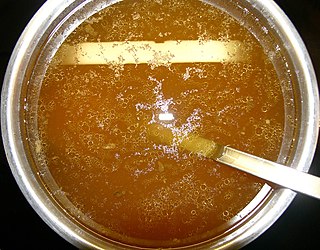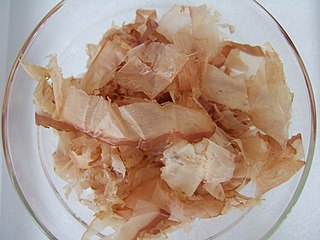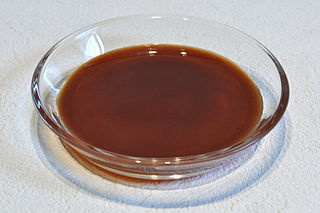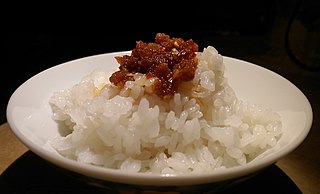 W
WUmami, or savoriness, is one of the five basic tastes. It has been described as savory and is characteristic of broths and cooked meats.
 W
WSeasoned salt is a blend of table salt, herbs, spices, other flavourings, and sometimes monosodium glutamate (MSG). It is sold in supermarkets and is commonly used in fish and chip shops and other take-away food shops. Seasoned salt is often the standard seasoning on foods such as chicken, french fries, deep-fried seafood, and potatoes.
 W
WAromat is a food seasoning, first introduced in 1953, and marketed internationally under the brand name Knorr, owned by the Unilever group. It is described by Knorr as an 'all purpose savoury seasoning'.
 W
WBagoong monamon, bagoong monamon-dilis, or simply bagoong and bugguong munamon in Ilocano, is a common ingredient used in the Philippines and particularly in Northern Ilocano cuisine. It is made by fermenting salted anchovies which is not designed, nor customarily used for immediate consumption since it is completely raw.
 W
WBroth, also known as bouillon [French pronunciation: [bu.jɔ̃]], is a savory liquid made of water in which bones, meat, fish or vegetables have been simmered. It can be eaten alone, but it is most commonly used to prepare other dishes, such as soups, gravies, and sauces.
 W
WA bouillon cube, stock cube, broth cube (Asia) or stock pot (UK) is dehydrated broth or stock formed into a small cube about 13 mm wide. It is typically made from dehydrated vegetables, meat stock, a small portion of fat, MSG, salt, and seasonings, shaped into a small cube. Vegetarian and vegan types are also made. Bouillon is also available in granular, powdered, liquid, and paste forms.
 W
WBovril is the trademarked name of a thick and salty meat extract paste similar to a yeast extract, developed in the 1870s by John Lawson Johnston. It is sold in a distinctive bulbous jar, and as cubes and granules. Bovril is owned and distributed by Unilever UK. Its appearance is similar to Marmite and Vegemite.
 W
WBudu is an anchovies sauce and one of the best known fermented seafood products in Kelantan, Terengganu in Malaysia, southern Thailand and Natuna islands in Indonesia and South Sumatra, Bangka island and Western Kalimantan of Indonesia. It is mentioned in A Grammar and Dictionary of the Malay language, With a Preliminary Dissertation, Volume 2, By John Crawfurd, published in 1852.
 W
WCenovis is a dark brown food paste consisting of yeast extract. It is similar to English Marmite, Brazilian Cenovit, and Australian Vegemite. It is rich in vitamin B1. It is used to flavour soups, sausages and salads. The most popular way to consume Cenovis, however, is to spread it on a slice of buttered bread, as stated on the product's packaging (or it can be blended into the butter and spread on bread or as a filling in croissants and buns).
 W
WSeasoned salt is a blend of table salt, herbs, spices, other flavourings, and sometimes monosodium glutamate (MSG). It is sold in supermarkets and is commonly used in fish and chip shops and other take-away food shops. Seasoned salt is often the standard seasoning on foods such as chicken, french fries, deep-fried seafood, and potatoes.
 W
WSeasoned salt is a blend of table salt, herbs, spices, other flavourings, and sometimes monosodium glutamate (MSG). It is sold in supermarkets and is commonly used in fish and chip shops and other take-away food shops. Seasoned salt is often the standard seasoning on foods such as chicken, french fries, deep-fried seafood, and potatoes.
 W
WDashi is a family of stocks used in Japanese cuisine. Dashi forms the base for miso soup, clear broth soup, noodle broth soup, and many simmering liquids to accentuate the savory flavor known as umami. Dashi is also mixed into the flour base of some grilled foods like okonomiyaki and takoyaki.
 W
WDisodium glutamate, abbreviated DSG, (Na2C5H7NO4) is a sodium salt of glutamic acid. It is used as a flavoring agent to impart umami flavor.
 W
WDisodium inosinate (E631) is the disodium salt of inosinic acid with the chemical formula C10H11N4Na2O8P. It is used as a food additive and often found in instant noodles, potato chips, and a variety of other snacks. Although it can be obtained from bacterial fermentation of sugars, it is often commercially prepared from animal products.
 W
WDisodium 5'-ribonucleotides, E number E635, is a flavor enhancer which is synergistic with glutamates in creating the taste of umami. It is a mixture of disodium inosinate (IMP) and disodium guanylate (GMP) and is often used where a food already contains natural glutamates or added monosodium glutamate (MSG). It is primarily used in flavored noodles, snack foods, chips, crackers, sauces and fast foods. It is produced by combining the sodium salts of the natural compounds guanylic acid (E626) and inosinic acid (E630).
 W
WDoenjang or soybean paste is a type of fermented bean paste made entirely of soybean and brine. It is also a byproduct of soup soy sauce production. It is sometimes used as a relish.
 W
WDouchi, or tochi is a type of fermented and salted black soybean. In English, it is known as fermented black soybeans, Chinese fermented black beans, salted black beans, salty black beans, or just black beans. They are a flavoring most popular in the cuisine of China, where they are most widely used for making black bean sauce dishes.
 W
WDried shrimp are shrimp that have been sun-dried and shrunk to a thumbnail size. They are used in many East Asian, Southeast Asian and South Asian cuisines, imparting a unique umami taste. A handful of shrimp is generally used for dishes. The flavors of this ingredient are released when allowed to simmer.
 W
WFermented bean paste is a category of fermented foods typically made from ground soybeans, which are indigenous to the cuisines of East, South and Southeast Asia. In some cases, such as the production of miso, other varieties of beans, such as broad beans, may also be used.
 W
WFermented fish is a traditional preservation of fish. Before refrigeration, canning and other modern preservation techniques became available, fermenting was an important preservation method. Fish rapidly spoils, or goes rotten, unless some method is applied to stop the bacteria that produce the spoilage. Fermentation is a method which attacks the ability of microbials to spoil fish. It does this by making the fish muscle more acidic; bacteria usually cease multiplying when the pH drops below 4.5.
 W
WFish sauce is a liquid condiment made from fish or krill that have been coated in salt and fermented for up to two years. It is used as a staple seasoning in East Asian cuisine and Southeast Asian cuisine, particularly Myanmar, Cambodia, China, Indonesia, Laos, Malaysia, Philippines, Taiwan, Thailand, and Vietnam. Some garum-related fish sauces have been used in the West since the Roman times.
 W
WGarum is a fermented fish sauce which was used as a condiment in the cuisines of Phoenicia, ancient Greece, Rome, Carthage and later Byzantium. Liquamen is a similar preparation, and at times they were synonymous. Although garum enjoyed its greatest popularity in the Western Mediterranean and the Roman world, it was earlier used by the Greeks.
 W
WGentleman's Relish is a British commercial brand of anchovy paste. It is also known as Patum Peperium. It was created in 1828 by an Englishman named John Osborn. It is a savoury paste with a salty and slightly fishy taste, and contains anchovies, butter, herbs and spices. Today, the secret recipe is withheld from all but one employee at Elsenham Quality Foods in Elsenham, England, the licensed manufacturer.
 W
WGlutamic acid is an α-amino acid that is used by almost all living beings in the biosynthesis of proteins. It is non-essential in humans, meaning that the body can synthesize it. It is also an excitatory neurotransmitter, in fact the most abundant one, in the vertebrate nervous system. It serves as the precursor for the synthesis of the inhibitory gamma-aminobutyric acid (GABA) in GABA-ergic neurons.
 W
WGlutamate flavoring is the generic name for flavor-enhancing compounds based on glutamic acid and its salts (glutamates). These compounds provide an umami (savory) taste to food.
 W
WKikunae Ikeda was a Japanese chemist and Tokyo Imperial University professor of chemistry who, in 1908, uncovered the chemical basis of a taste he named umami. It is one of the five basic tastes along with sweet, bitter, sour and salty.
 W
WIrú or Eware (Edo) is a type of fermented and processed locust beans used as a condiment in cooking. It is similar to ogiri and douchi. It is very popular among the Yoruba people and Edo people of Nigeria. It is used in cooking traditional soups like egusi soup, okro soup, Ewedu soup and ogbono soup. Among the Manding-speaking people of West Africa irú is known as sumbala. The Yorubas classify iru into two types: Irú Wooro which is commonly use in making stew and Irú pẹ̀tẹ̀ which is used in making ewedu and egusi soup.
 W
WKatsuobushi is simmered, smoked and fermented skipjack tuna. It is also known as bonito flakes. Katsuobushi or similarly prepared fish is also known as okaka (おかか).
 W
WKonbu is edible kelp mostly from the family Laminariaceae and is widely eaten in East Asia. It may also be referred to as dasima or haidai.
 W
WMaggi is an international brand of seasonings, instant soups, and noodles that originated in Switzerland in the late 19th century. The Maggi company was acquired by Nestlé in 1947.
 W
WMarmite ( MAR-myte) is a savoury food spread made from yeast extract that was invented by German scientist Justus von Liebig and originally made in the United Kingdom. It is a by-product of beer brewing and is currently produced by British company Unilever. The product is notable as a vegan source of B vitamins, including supplemental vitamin B12. A traditional use is to spread it very thinly on buttered toast.
 W
WMarmite is a food spread produced in New Zealand by Sanitarium Health and Wellbeing Company and distributed in Australia and the Pacific. Marmite is made from yeast extract, a by-product of beer brewing. It is similar to the British Marmite, but the two products are made by different companies.
 W
WMeat extract is highly concentrated meat stock, usually made from beef. It is used to add meat flavour in cooking, and to make broth for soups and other liquid-based foods.
 W
WMiso is a traditional Japanese seasoning produced by fermenting soybeans with salt and kōji and sometimes rice, barley, seaweed, or other ingredients. The result is a thick paste used for sauces and spreads, pickling vegetables, fish, or meats, and mixing with dashi soup stock to serve as miso soup, a Japanese culinary staple. High in protein and rich in vitamins and minerals, miso played an important nutritional role in feudal Japan. Miso is still widely used in Japan, both in traditional and modern cooking, and has been gaining worldwide interest.
 W
WMonosodium glutamate (MSG), also known as sodium glutamate, is the sodium salt of glutamic acid. MSG is found naturally in some foods including tomatoes and cheese. MSG is used in cooking as a flavor enhancer with an umami taste that intensifies the meaty, savory flavor of food, as naturally occurring glutamate does in foods such as stews and meat soups.
 W
WNgapi, formerly also spelled ngapee, nga-pee and gnapee, is a pungent paste made of either fish or shrimp in Burmese cuisine. Ngapi is usually made by fermenting fish or shrimp that is salted and ground then sundried. Like cheese, it can be distinguished based on main ingredient and regional origin. Ngapi can be distinguished by the type of fish used to make it. Ngapi can come from whole fish, from small fish or from prawns. Ngapi is a main ingredient of Lower Burmese cooking and is used as a condiment or additive in most dishes. Raw ngapi, with some exceptions, is not intended for direct consumption.
 W
WNutritional yeast, also referred to as nooch or hippy dust, is a deactivated yeast, often a strain of Saccharomyces cerevisiae, that is sold commercially as a food product. It is sold in the form of yellow flakes, granules, or powder and can be found in the bulk aisle of most natural food stores. It is popular with vegans and vegetarians and may be used as an ingredient in recipes or as a condiment.
 W
WOxo is a brand of food products, including stock cubes, herbs and spices, dried gravy, and yeast extract. The original product was the beef stock cube, and the company now also markets chicken and other flavour cubes, including versions with Chinese and Indian spices. The cubes are broken up and used as flavouring in meals or gravy or dissolved into boiling water to produce a bouillon.
 W
WPadaek, sometimes known as padek, or Lao fish sauce, similar to pla ra in Thailand, is a traditional Lao condiment made from pickled or fermented fish that has been cured. It is thicker and more seasoned than the fish sauce more commonly seen throughout Thailand and Vietnam, often containing chunks of fish. The fermentation takes a long time, giving padaek an aroma similar to cheeses like Époisses. Unlike other versions of fish sauce in Southeast Asia, padaek is made from freshwater fish, owing to the landlocked nature of the former kingdom of Lan Xang. Padaek is used in many dishes, most notably tam maak hoong, a spicy Lao papaya salad.
 W
WParmigiano-Reggiano is an Italian hard, granular cheese produced from cow's milk and aged at least 12 months.
 W
WPrahok is a crushed, salted and fermented fish paste that is used in Cambodian cuisine as a seasoning or a condiment. It originated as a way of preserving fish during the months when fresh fish was not available in abundant supply. Because of its saltiness and strong flavor, it was used as an addition to many meals in Cambodian cuisine, such as soups and sauces. A Cambodian saying goes, "No prahok, no salt", referring to a dish that is of poor flavor or bland thus highlighting its essentiality in Cambodian cuisine. Prahok has a strong and distinct smell, earning the nickname "Cambodian cheese". Prahok is usually eaten as a main course with white rice and vegetable such as yardlong bean, cucumbers, and Thai eggplant.
 W
WSaccharina japonica is a marine species of the Phaeophyceae plant, a type of kelp or seaweed, which is extensively cultivated on ropes between the seas of China, Japan and Korea. It is widely eaten in East Asia. A commercially important species, S. japonica is also called ma-konbu (真昆布) in Japanese, dasima (다시마) in Korean and hǎidài (海带) in Chinese. Large harvests are produced by rope cultivation which is a simple method of growing seaweeds by attaching them to floating ropes in the ocean.
 W
WShottsuru (塩魚汁) is a pungent regional Japanese fish sauce similar to the Thai nam pla. The authentic version is made from the fish known the hatahata, and its production is associated with the Akita region.
 W
WShrimp paste or prawn sauce is a fermented condiment commonly used in Southeast Asian and Southern Chinese cuisines. It is primarily made from finely crushed shrimp or krill mixed with salt, and then fermented for several weeks. They are either sold in their wet form or are sun-dried and either cut into rectangular blocks or sold in bulk. It is an essential ingredient in many curries, sauces and sambal. Shrimp paste can be found in many meals in Cambodia, Indonesia, Laos, Malaysia, Myanmar, the Philippines, Singapore, Thailand, and Vietnam. It is often an ingredient in dip for fish or vegetables.
 W
WGuk-ganjang or soup soy sauce is a type of Korean soy sauce (ganjang) made entirely of fermented soybeans (meju) and brine. It is also a byproduct of doenjang production. Both lighter in colour and saltier than other Korean ganjang varieties, soup soy sauce is used mainly in guk (soup) and namul in modern Korean cuisine.
 W
WSoy sauce is a liquid condiment of Chinese origin, traditionally made from a fermented paste of soybeans, roasted grain, brine, and Aspergillus oryzae or Aspergillus sojae molds. It is considered to contain a strong umami flavor.
 W
WSteak sauce is a tangy sauce commonly served as a condiment for beef in the United States. Two of its major producers are British companies, and the sauce is similar to the "brown sauce" of British cuisine.
 W
WVegemite is a thick, dark brown Australian food spread made from leftover brewers' yeast extract with various vegetable and spice additives. It was developed by Cyril Callister in Melbourne, Victoria in 1922.
 W
WWorcestershire sauce is a fermented liquid condiment created in the city of Worcester in Worcestershire, England during the first half of the 19th century. The creators were pharmacists John Wheeley Lea and William Henry Perrins, who went on to form the company Lea & Perrins. Worcestershire sauce has been considered a generic term since 1876, when the English High Court of Justice ruled that Lea & Perrins did not own a trademark for the name Worcestershire.
 W
WXO sauce is a spicy seafood sauce from Hong Kong with an umami flavour. It is commonly used in southern Chinese regions such as Guangdong.
 W
WYeast extracts consist of the cell contents of yeast without the cell walls; they are used as food additives or flavorings, or as nutrients for bacterial culture media. They are often used to create savory flavors and umami taste sensations, and can be found in a large variety of packaged food, including frozen meals, crackers, snack foods, gravy, stock and more. They are rich in B vitamins, and so are of particular importance to vegans and vegetarians. Yeast extracts and fermented foods contain glutamic acid, an amino acid which adds an umami flavor. Glutamic acid is found in meat, cheese, fungi (mushrooms), and vegetables—such as broccoli, and tomatoes.